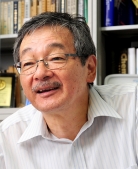

报告题目:Particulate photocatalysts for water splitting to produce solar hydrogen
报告时间:2022年11月15日上午10:00-11:30
报告地点:腾讯会议
会议ID: 840-9537-3327
报 告 人:Prof. Kazunari Domen(教授、信洲大学&东京大学)
报告主持人:Prof. Masakazu Ampo(教授、福州大学&日本大阪公立大学)
报告摘要:
Photocatalytic water splitting driven by sunlight has been attracting growing interest as a means of producing renewable solar hydrogen on a large scale [1]. It is essential to improve the solar-to-hydrogen energy conversion efficiency (STH) of particulate photocatalysts and develop reaction systems radically. In my talk, recent advances in photocatalytic materials and reaction systems will be presented.
The author’s group has studied various semiconductor oxides, (oxy)nitrides, and (oxy)chalcogenides as photocatalysts for water splitting [2]. Recently, the apparent quantum yield of SrTiO3 in photocatalytic overall water splitting has been improved to more than 90% at 365 nm, equivalent to an internal quantum efficiency of almost unity [3]. This quantum efficiency is the highest yet reported and indicates that a particulate photocatalyst can drive the endergonic overall water splitting reaction at a quantum efficiency comparable to values obtained in photon-to-chemical conversion processes of photosynthesis. The author's group has also been developing panel reactors for large-scale applications. A solar hydrogen production system based on 100-m2 arrayed photocatalytic water splitting panels and an oxyhydrogen gas-separation module was built, and its performance and system characteristics including safety issues were reported recently [4].
For practical solar energy harvesting, it is essential to develop photocatalysts that are active under visible light irradiation. We previously reported Ta3N5 and Y2Ti2O5S2 photocatalysts are active in overall water splitting via one-step excitation under visible light irradiation [5,6]. Particulate photocatalyst sheets consisting of La- and Rh-codoped SrTiO3 and Mo-doped BiVO4 efficiently split water into hydrogen and oxygen via two-step excitation, referred to as Z-scheme, with a STH exceeding 1.0% [7]. In my talk in this year, I focus on some new photocatalysts developed recently. Some oxychalcogenides and oxynitrides with long absorption edge wavelengths will be introduced to apply for one-step and Z-scheme photocatalyst (sheets) [8,9].
[1] T. Hisatomi, K. Domen, Nat. Catal. 2, 387 (2019).
[2] S. Chen, T. Takata, K. Domen, Nat. Rev. Mater. 1, 17050 (2017).
[3] T. Takata, J. Jiang, Y. Sakata et al., Nature 581, 411 (2020).
[4] H. Nishiyama, T. Yamada, M. Nakabayashi et al., Nature 598, 304 (2021).
[5] Z. Wang, Y. Inoue, T. Hisatomi et al., Nat. Catal. 1, 756 (2018).
[6] Q. Wang, M. Nakabayashi, T. Hisatomi et al., Nat. Mater. 18, 827 (2019).
[7] Q. Wang, T. Hisatomi, Q. Jia et al., Nat. Mater. 15, 611 (2016).
[8]H.H. Li et al, ACS Catalysis, 12(16), 10179 (2022).
[9]JD. Xiao, Angew. Chem. Intl. Ed., 61 (2022).

报告人简介:
Prof. Kazunari Domen(堂免一成先生),分别于1976年、1979年、1982年在东京大学科学学院获得学士、硕士、博士学位。1982-2004年在东京工业大学从事助理研究员、副教授和教授, 2004年至今任东京大学工学院化学工程系教授,2017年起在日本信州大学能源与环境科学中心担任特聘教授。获得的荣誉奖项有:2007年获日本催化协会奖,2011年获日本化学会奖。研究兴趣有:光催化分解水研究、基于红外光谱的多相催化研究、基于非线性激光光谱的表面动力学反应研究,以及新型功能化催化材料的开发。